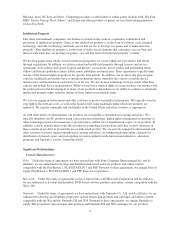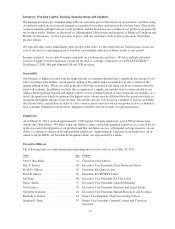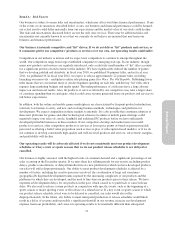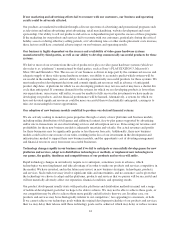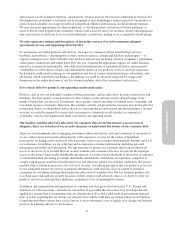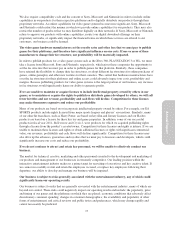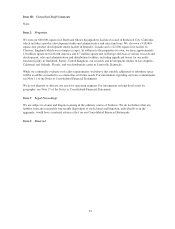Electronic Arts 2011 Annual Report Download - page 91
Download and view the complete annual report
Please find page 91 of the 2011 Electronic Arts annual report below. You can navigate through the pages in the report by either clicking on the pages listed below, or by using the keyword search tool below to find specific information within the annual report.
Annual Report
and increase our development expenses. Alternatively, we may increase the resources employed in research and
development in an attempt to accelerate our development of new technologies, either to preserve our product or
service launch schedule or to keep up with our competition, which would increase our development expenses.
We may also miss opportunities to adopt technology, or develop products and services for new platforms or
services that become popular with consumers, which could adversely affect our revenues. It may take significant
time and resources to shift our focus to such technologies or platforms, putting us at a competitive disadvantage.
We may experience outages and disruptions of our online services if we fail to maintain adequate
operational services and supporting infrastructure.
As we increase our online products and services, we expect to continue to invest in technology services,
hardware and software — including data centers, network services, storage and database technologies — to
support existing services and to introduce new products and services including websites, ecommerce capabilities,
online game communities and online game play services. Creating the appropriate support for online business
initiatives is expensive and complex, and could result in inefficiencies or operational failures, and increased
vulnerability to cyber attacks, which could diminish the quality of our products, services, and user experience.
Such failures could result in damage to our reputation and loss of current and potential users, subscribers, and
advertisers which could harm our business. In addition, we could be adversely impacted by outages and
disruptions in the online platforms of our key business partners, who offer our products and services.
If we release defective products, our operating results could suffer.
Products such as ours are extremely complex software programs, and are difficult to develop, manufacture and
distribute. We have quality controls in place to detect defects in the software, media and packaging of our
products before they are released. Nonetheless, these quality controls are subject to human error, overriding, and
reasonable resource constraints. Therefore, these quality controls and preventative measures may not be effective
in detecting defects in our products before they have been reproduced and released into the marketplace. In such
an event, we could be required to or may find it necessary to voluntarily recall a product or suspend its
availability, which could significantly harm our business and operating results.
Our business could be adversely affected if our consumer data protection measures are not seen as
adequate; there are breaches of our security measures or unintended disclosures of our consumer data.
There are several inherent risks to engaging in business online and directly with end consumers of our products.
As we conduct more transactions online directly with consumers, we may be the victim of fraudulent
transactions, including credit card fraud, which presents a risk to our revenues and potentially disrupts service to
our consumers. In addition, we are collecting and storing more consumer information, including personal
information and credit card information. We take measures to protect our consumer data from unauthorized
access or disclosure. It is possible that our security controls over consumer data may not prevent the improper
access or disclosure of personally identifiable information. A security breach that leads to disclosure of consumer
account information (including personally identifiable information) could harm our reputation, compel us to
comply with disparate state breach notification laws and otherwise subject us to liability under laws that protect
personal data, resulting in increased costs or loss of revenue. A resulting perception that our products or services
do not adequately protect the privacy of personal information could result in a loss of current or potential
consumers for our online offerings that require the collection of consumer data. Our key business partners also
face these same risks and any security breaches of their system could adversely impact our ability to offer our
products and services through their platforms, resulting in a loss of meaningful revenues.
In addition, the interpretation and application of consumer and data protection laws in the U.S., Europe and
elsewhere are often uncertain, contradictory and in flux. It is possible that these laws may be interpreted and
applied in a manner that is inconsistent with our data practices. If so, this could result in government imposed
fines or orders requiring that we change our data practices, which could have an adverse effect on our business.
Complying with these various laws could cause us to incur substantial costs or require us to change our business
practices in a manner adverse to our business.
15





